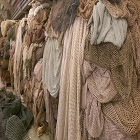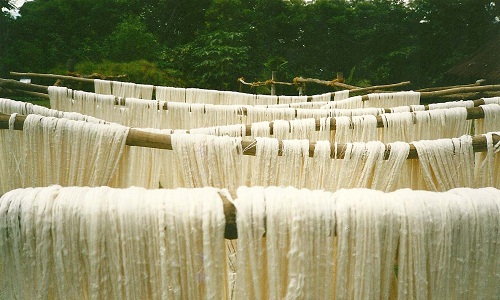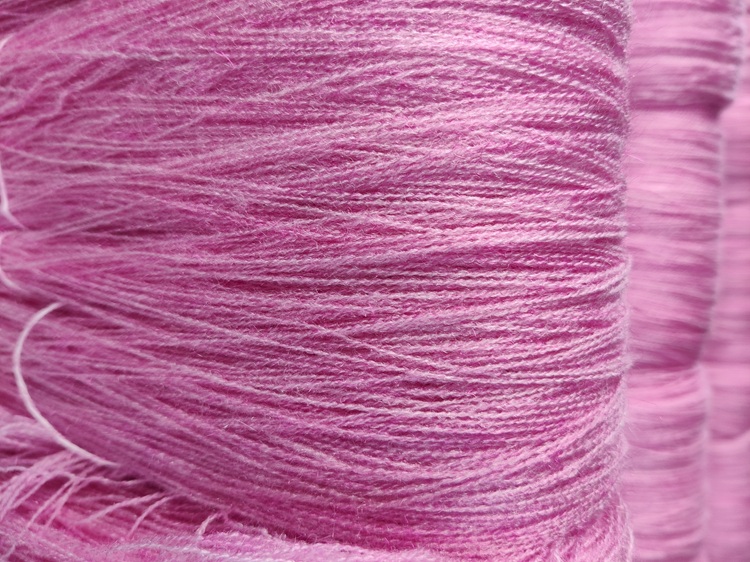FW
Los Angeles-based fashion brand American Apparel has closed all but one of its 13 UK stores. The move resulted in a loss of 150 jobs. The brand, known for hot pants and slinky leggings, put its UK business into administration last month just before the troubled parent company struck a deal with Canadian T-shirt maker Gildan Active wear that will take over all the closed stores.
It is heard that Gildan bought the worldwide rights of the American Apparel brand for $66m (£54m). American Apparel has also filed for bankruptcy and the retailer has begun winding up its businesses in Spain, Japan and Australia as part of the deal with Gildan, which is expected to be finalised early next year. The only Irish store closed a few weeks ago.
As many as twenty three textile companies from Bangladesh are gearing up to exhibit their products at Heimtextil, the international trade fair for home, towel and contract textiles, to be held in Frankfurt from January 10 to 13, it is understood.
Of the 23 companies, 10 firms would take part in the exhibition under the arrangement of the Export Promotion Bureau while the rest would participate directly. The companies include ACS Textiles (Bangladesh) Limited, Apex Weaving and Finishing Mills Ltd, Mom Tex Limited, Noman Terry Towel Mills Limited, Regent Textile Mills Pvt Ltd, Shabab Fabrics Ltd, Towel Tex Limited, Unilliance Textiles Ltd, Shamsuddin Towels, Hossain Dyeing, Zaber & Zubair Fabrics Limited, Anik Composite Mills Ltd, Instinct Textile Ltd, Miray Towel Industries Limited, Virgin Grace Ltd, Jaantex Industries Ltd, Manuri Textile Mills, RTT Textile Industries Pvt Ltd, Eke Tex(Pvt) Ltd and Asix and RTT Textile Industries (Pvt) Ltd. Organisers informed that more than 2,886 exhibitors from 69 countries would take part at Heimtextil.
"With growing focus on the 3Rs – Reduce, Reuse, Recycle, textile companies are finding ways and means to recycle fabrics. The key to the new generation of recycled synthetics is they are becoming as good in performance and function as their virgin counterparts. Cordura EcoMade, made from recycled polyester, is a case in point, with Cordura renowed for its high tenacity, the recycled alternative is specifically engineered to meet the fabric performance and durability specifications of the Cordura brand."

With growing focus on the 3Rs – Reduce, Reuse, Recycle, textile companies are finding ways and means to recycle fabrics. The key to the new generation of recycled synthetics is they are becoming as good in performance and function as their virgin counterparts. Cordura EcoMade, made from recycled polyester, is a case in point, with Cordura renowed for its high tenacity, the recycled alternative is specifically engineered to meet the fabric performance and durability specifications of the Cordura brand. Plain, dobby and rip stop weaves based on 600 denier yarn count can be incorporated, working perfectly for day packs. The process to produce Cordura EcoMade fabric reduces energy consumption and extends the use of the polyester.
Success stories

Patagonia has been diverting resources from the landfill since 1993 when they made the first fleece from recycled plastic bottles. Today they are using more recycled materials in their collection without sacrificing performance or quality. This season witnessed the launch of the recollection – styles made with all sorts of recycled materials, including 100 per cent recycled down, 100 per cent recycled wool and 100 per cent recycled polyester with 85 per cent recycled polyester labels, 80 per cent recycled zippers and 50 per cent recycled buttons. This is radically resourceful clothing, built to keep you warm, and they are ready to be recycled again when the time comes.
Take-Back-Systems – retailers taking responsibility
In another first, Patagonia is offering a worn wear repair service to its products, ensuring a longer life cycle to the consumer. Additionally, it is one of the brands to offer a take-back system for unwanted clothes and footwear, with more retailers pushing this closed-loop philosophy, reducing landfill of unwanted garments. But what happens when you take your old kit to the store, where does it go and how is it processed? I:Collect, part of the Soex Group, is an international provider for collection, reuse and recycling solutions for clothing and show, with national subsidiaries in Germany, the United Kingdom, Japan and the United States. Its take-back system and worldwide partner network, the company is able to both directly reuse clothing and pre-process the key ingredients before returning them to different production cycles.
The I:CO take-back system offers the retail industry the capability of assuming product responsibility by companies taking back clothing and shoes directly at their points of sale for reuse and recycling purposes. Consumers in more than 65 countries can deposit clothing and shoes conveniently at one of the many I:CO trading partners. In return, they receive a voucher for their next purchase. All the collected items are transported to sorting and recycling centers where every piece of clothing is sorted by hand and categorized for its best possible use.
Clothing that can still be worn, which account for up to 60 per cent of the total returns is preserved and sold according to quality aspects. The remaining 40 per cent is stripped and processed into different end products from recycled yarns, in particular garments wool and cotton, through to insulation materials. Buttons and hard materials retrieved from the shredding of garments are sorted out for use in the metalworking industry.
Full circle natural fibers
Filatures du Parc has developed a new yarn made from recyclable and recycled fibers with the patented manufacturing system. The recycled fibres are made from post-consumer jeans, collected through European partners. The jeans are selected and sorted on shades, like clear, medium and dark jeans. Filatures du Parc transforms the jeans fabrics into fibers and blends them with PET, which is recycled fiber polyester from plastic bottles.
The commonly used shredding system for fibre-recycling damages and shortens the fibers. As a result, the pilling quality is bad. The new fiber recycling process maintains fiber length which results in good quality yarns. Consequently, this new type of yarn has the same characteristics – sometimes even better – as yarn made from original fibres, particularly when it comes to breaking strength, elongation, abrasion, pilling and colour fastness.
Saving on natural resources
Synthetic and cellulosic fibers require large amounts of water and energy in the production process. This has a big impact on the environment. In the contrary, recycled fibers reduce the environmental impact of the production process. The patented yarn spinning process of Filatures du Parc also reduces dye pollution. Tessile Fiorentina has created a technical wool collection made out of reclaimed wool garments. Based in Prato, Italy, the company collects garments that they shred and spin into a recycled wool fiber. By sorting into colours prior to spinning, the recycled fibre does not need to be dyed, thereby saving water. It also offers the flexibility to play with different colours in one yarn to create something unique. The performance collection is woven in 100 per cent wool fabrics or blended with synthetics for added performance.
Companies in China are increasingly shifting their production base of low value-added goods out of the country. The reason is the wages have been doubled in the last five years when apparel makers have been under heavy pressure from clients to cut costs. The country exports about $169 billion worth of clothing annually.
More and more Chinese apparel makers have been prompted to shift their production base to neighbouring Vietnam where labour costs are about 60 per cent lower. Such moves do involve a certain amount of risk due to the nations' territorial dispute in the South China among other factors.
Nameson Holdings, maker of sweaters and other knitwear-to-order based in the Guangdong Province plans to increase production in Vietnam. The company began production in the Southeast Asian country at a factory in the suburbs of Ho Chi Minh City in 2015. It expects to complete the second phase of construction at the plant in April next year.
Nameson mainly supplies garments to Japan's Fast Retailing, operator of the Uniqlo chain of casual clothing stores. Over half of the Chinese company's revenue comes from sales to the Japanese retailer.
Nameson's production shift is partly due to a 2009 economic partnership deal that has in principle eliminated tariffs on Vietnamese textile exports to Japan. Nameson is trying to expand its customer base in Japan.
Bosideng International Holdings, a major Chinese manufacturer and retailer of down jackets has also started its output unit in Vietnam. It currently produces garments on a trial basis at a Vietnamese textile factory affiliated with Japanese trading company Itochu, with which it has a capital partnership.
Vietnam Customs has reported that in November last, imports of raw cotton provisionally totaled 75,516 tonnes of which 43,480 tonnes were attributed to foreign direct-invested enterprises. Among the countries that imported cotton from Vietnam were United States (25,010 tonnes) followed closely by Brazil (24,843). On the imports side, 9,802 tonnes arrived from Australia, 2,277 tonnes from India and 1,802 tonnes from Pakistan.
Of this year’s total, imports from the United States accounted for 169,262 tonnes, those from Australia 64,929 tonnes and Brazil supplied 45,724 tonnes. The figure for the US is more than twice that recorded during the corresponding timeframe in 2015. In the first four months of the international statistical season that commenced from August 1, imports amounted to 342,275 tonnes against 327,791 tonnes that were recorded during the same period last year.
The Isle of Wight County lost one-third of its entire cotton crop this year mainly due to torrential rain that drenched the area in September and October. It is a county located in the U.S. state of Virginia. The County was named after the Isle of Wight.
The Isle of Wight County board of supervisors voted last week to ask Gov. Terry McAuliffe to declare the county an agriculture disaster area. This, according to them would enable farmers to apply for low-interest emergency loans. Cotton thrives in dry heat and the crop has done well in the county, according to Rex Alphin, farmer and chairman of the Board of Supervisors. Unfortunately this year, after Hurricane Matthew, farmers were shocked to see how much cotton was actually lost, Alphin exclaimed. The total loss was estimated at $2.4 million.
Alphin planted 150 acres of cotton on his 1,400 acre farm on River Run Trail and lost roughly half of that. A lot of farmers fall back on crop insurance but can't live off the insurance year after year, he observed.
Spencer Neale, secretary of the Virginia Cotton Grower's Association and Virginia Farm Bureau employee, said that crop insurance reimburses the farmers for lost crops but doesn't assist with quality-related loss. Johnny Parker, who's worked at the Commonwealth Gin in Windsor for 20 years, said that the average cotton yield in the county is about two bails per acre or roughly around 1,100 pounds. Parker believes that the county lost a large chunk as much as 400 pounds per acre during a particularly muggy and rainy three-week stretch. Despite this year's disappointing yield in cotton, farmers here are hopeful about the crop.
According to chairman of Southern India Mills’ Association (SIMA), M. Senthil Kumar the Indian textile industry is expected to attract investments of Rs. 1 lakh crore ($14.74 bn) in technical textiles by 2025. He was speaking at a conference on technical textiles and non-wovens organised by Federation of Indian Chambers of Commerce and Industry in Coimbatore yesterday.
Kumar said of the twelve major technical textile items, packtech has the largest share with 42 per cent. The next in line are industrial textiles and home textiles each accounting for about 10 per cent.
Technical textiles is one of the fastest growing segments in the textile industry and has registered an annual compounded growth rate of 11 per cent. It has the potential to grow to 20 per cent. However, the production capacity is currently focused on commodity products and not on innovative ones. The industry should make investments in technology, especially in Tamil Nadu, to tap the potential in technical textiles.
According to a presentation made by an official of the Regional Office of the Textile Commissioner here, the technology mission on technical textiles launched in 2010 with an outlay of Rs. 200 crore ($.03 bn) was extended till the end of this financial year with an additional outlay of Rs. 55.2 crore($8.14 mn).
As per Raja M. Shanmugham, president of Tirupur Exporters’ Association, Tirupur aims to touch an annual turnover of Rs. 1 lakh crore ($14.74 bn) by 2020 from the current Rs. 36,000 crore ( $5.3bn) . Industries in Tirupur need to look at different products including technical textiles to achieve this target. The Central Government should establish centres of excellence in hubs such as Tirupur.
Scores of garment factories in Bangladesh have shut down as workers went on strike. This could in a way hit supplies to top Western retailers during the busy holiday season.
The Bangladesh Garment Manufacturers and Exporters Association (BGMEA) closed 55 factories in a suburb on the outskirts of Dhaka, association president Siddikur Rahman said, after police arrested at least seven people who were leading the strike. These factories will remain closed until the government says it is safe to reopen them, Rahman added.
Here, it must be noted that workers there went on strike nine days ago in protest against the firing of 121 of their colleagues and soon added a pay hike to their list of demands. The protest escalated earlier this week when police fired rubber pellets, injuring 10 demonstrators according to labour leader Taslima Akhter.
Several hundred policemen have since been deployed in the industrial zone, home to the factories which supply leading Western retailers such as GAP, Zara and H&M. The workers want their salaries to be tripled from 5,300 taka (USD 67) to 16,000 taka.
The government raised the minimum wage for garment workers to 5,300 taka in 2013 after the industry came under intense international scrutiny over a series of disasters that killed scores. But even after the increase, Bangladeshi garment workers remain among the lowest paid in the textile sector in the world.
Bangladesh's USD 30 billion garment industry has a woeful history of poor pay and conditions for its four million workers. The garment workers have vowed to continue the strike until their demands are met. Garment manufacturing makes up for 80 per cent of Bangladesh's exports and a prolonged interruption would have a cascading impact on the impoverished country's economy.
Among various forms of slavery, employing children in the textile industry in India is a cause of concern. It is said that the practice of slavery is rampant in more than 90 per cent of South India's spinning mills that produce yarn for Western brands.
Researchers have asked for mapping of supply chains and do tougher audits. The India Committee of the Netherlands (ICN), a human rights organization, spoke to workers from almost half the mills in Tamil Nadu, the largest producer of cotton yarn in the country.
Most female workers employed in the 734 mills involved in the research were aged between 14 and 18, ICN reported and up to 20 per cent of the workers were younger than 14. The concerned report further states that employees were forced to work long hours by employers who often withheld their pay or locked their employees in company-controlled hostels. Many of them also faced sexual harassment. ICN Director claimed in a statement that they have raised the issue for five years now, but even to them the scale of this problem came as a shock.
K. Venkatachalam, chief advisor of the Tamil Nadu Spinning Mills Association said that he was not aware of the research. He said the state government had recently filed a report in the Madras High Court clearly stating that these issues are no longer prevalent in the industry and the matter has been closed.
India is one of the world's largest textile and garment manufacturers. The southern state of Tamil Nadu is home to some 1,600 mills employing between 200,000 and 400,000 workers. Traditionally the dyeing units, spinning mills and apparel factories have drawn on cheap labor from villages across Tamil Nadu to turn cotton into yarn, fabric and clothes, most of it for Western high street shops.
Polish company Inovatica sp. z o.o. has developed ‘biotextile’ an innovative T-shirt fitted with bio-monitoring capacities that allows to perform electrocardiography (EKG) on the patient wearing it. Bogumil Zieba, the company’s managing director, confirmed that Inovatica aims to launch large-scale production of the particular T-shirt and that the next phase of the project will be to introduce it to the domestic and foreign markets.
Senior company representatives said that bio-monitoring system could be integrated with the T-shirt in a way that would make it possible to wash and clean it and use it in a regular way. The product should also allow recording the electrical activity of a patient’s heart with the use of electrodes placed on their skin.
The company is currently working on developing a new technology that would help allow producing individual T-shirts based on a 3D scan of the patient’s body. Once the necessary technology is available, Inovatica will introduce its bio-textile product to the Polish markets and also launch export sales of the T-shirt.












